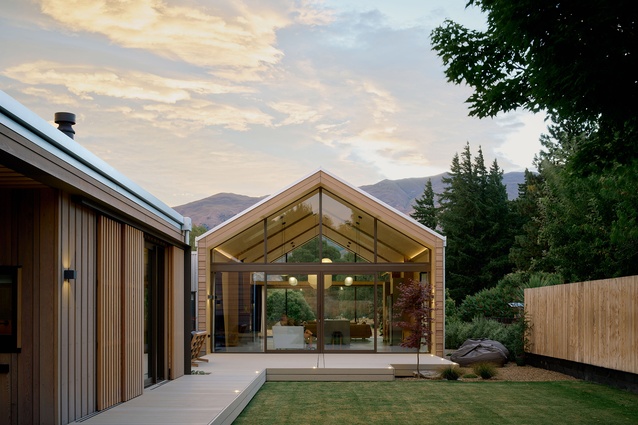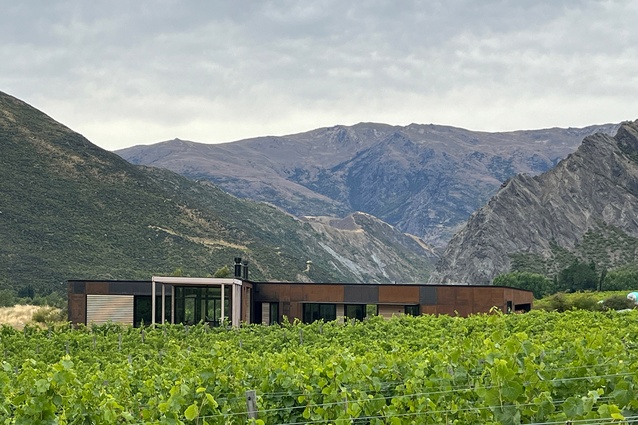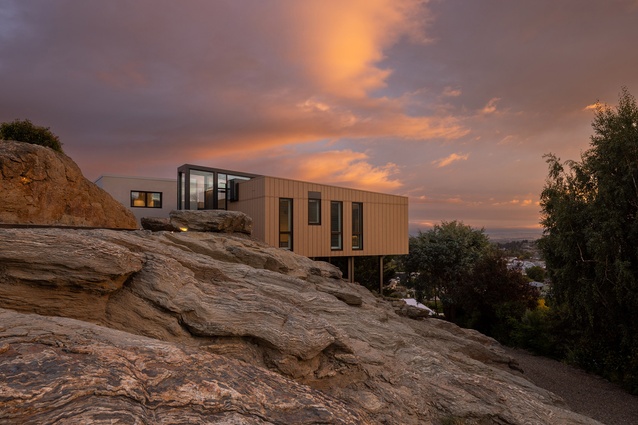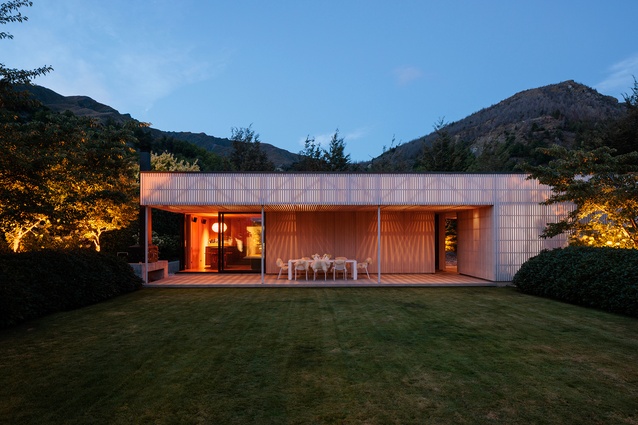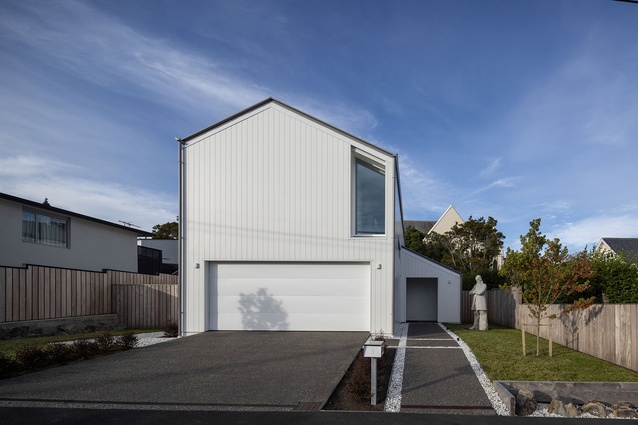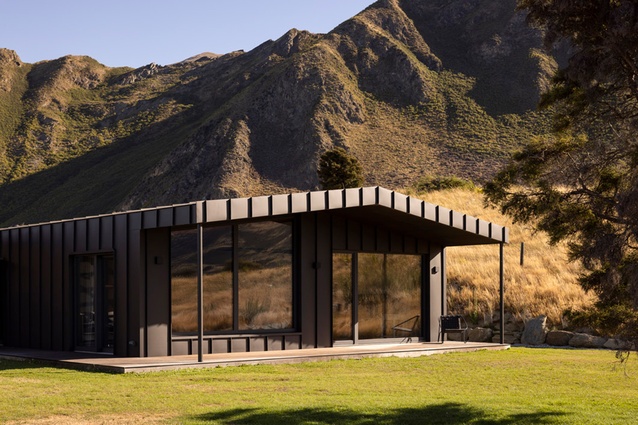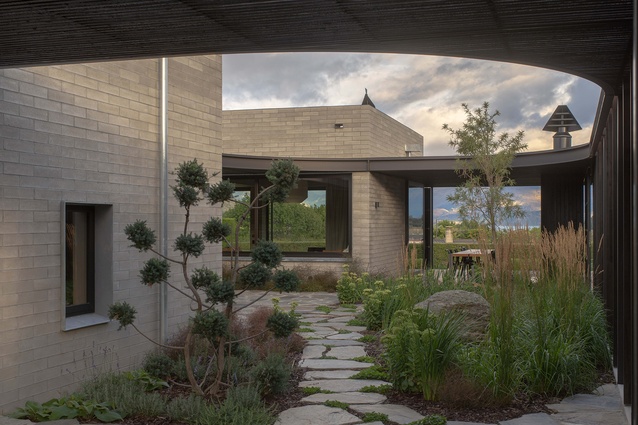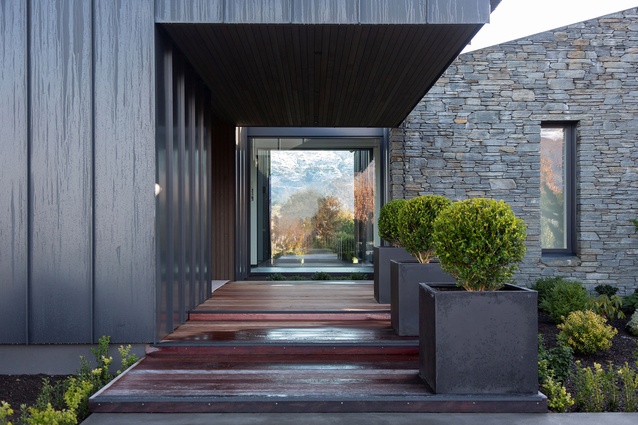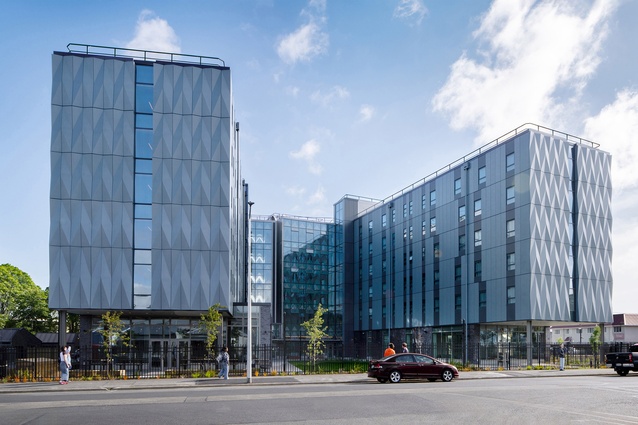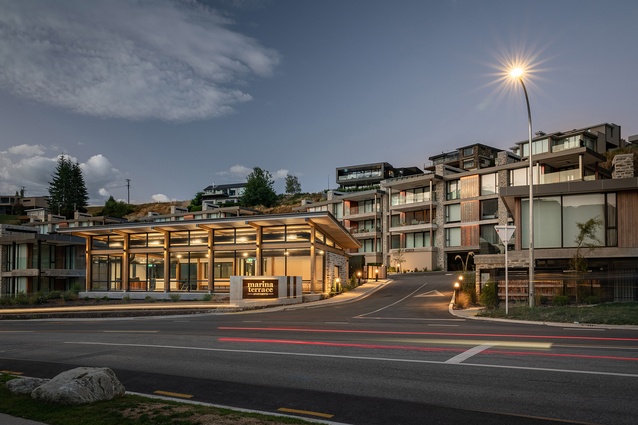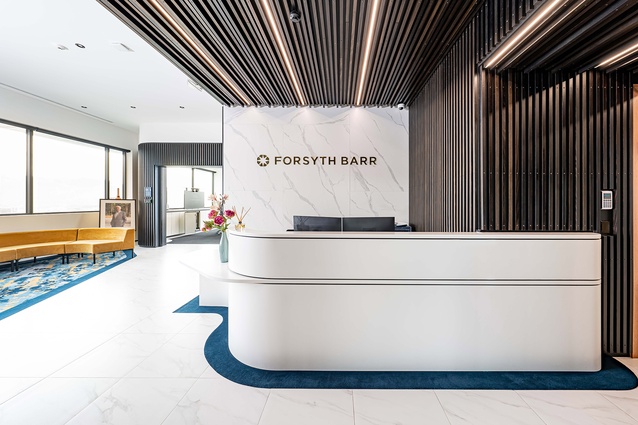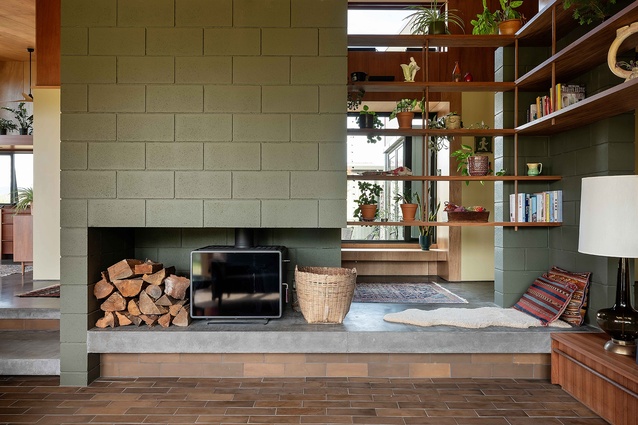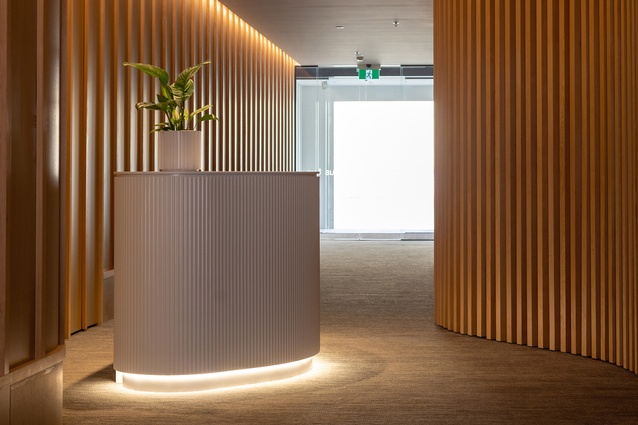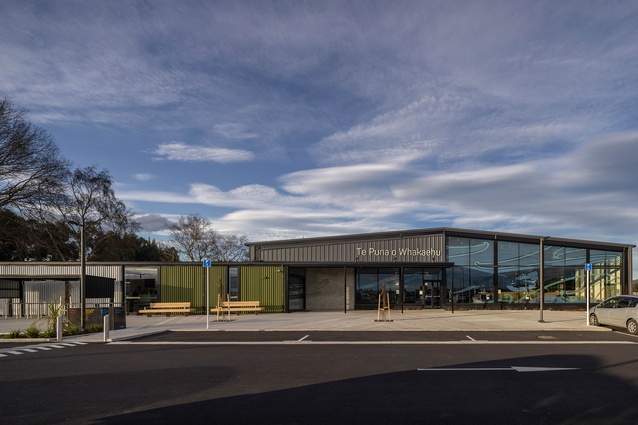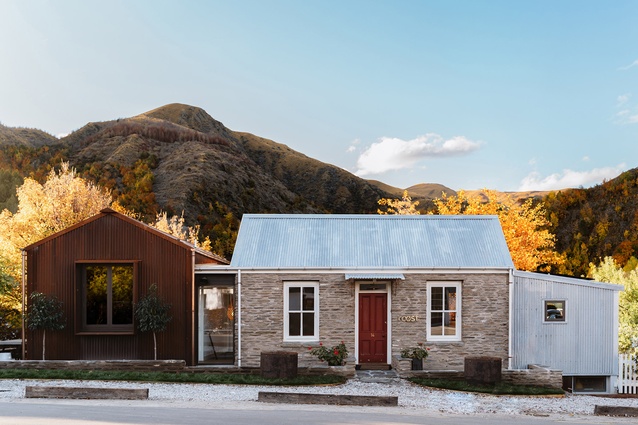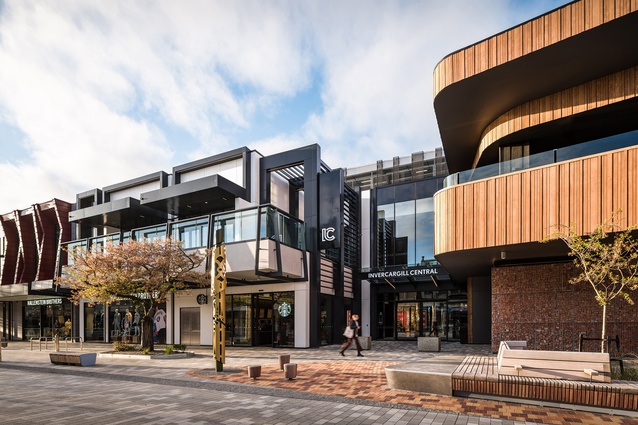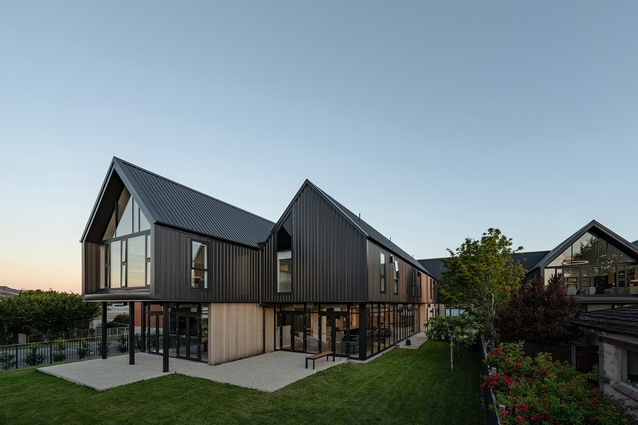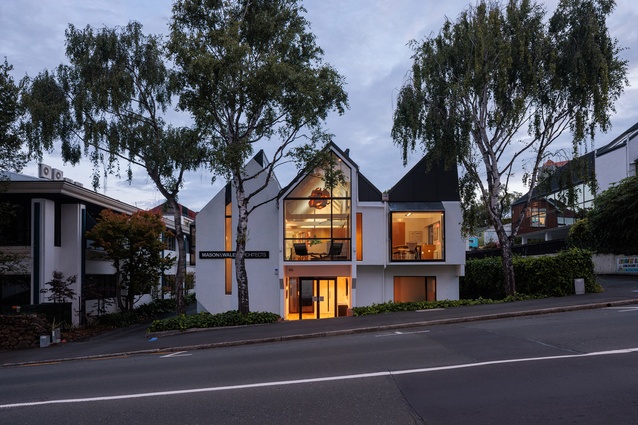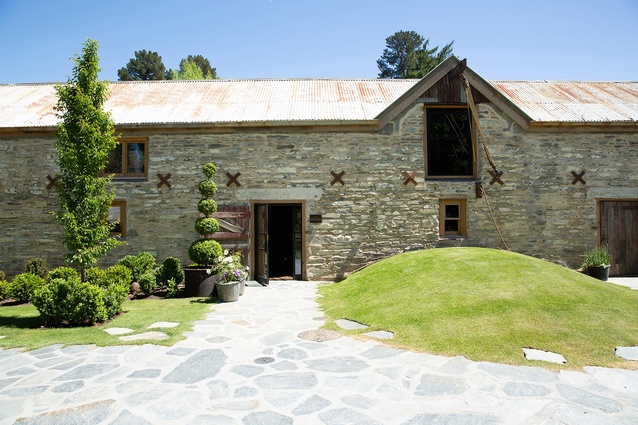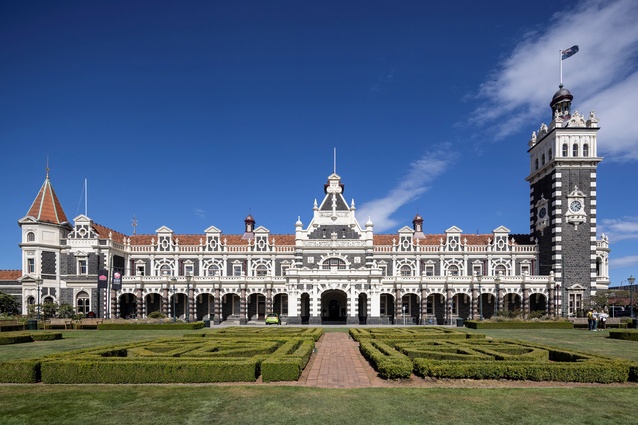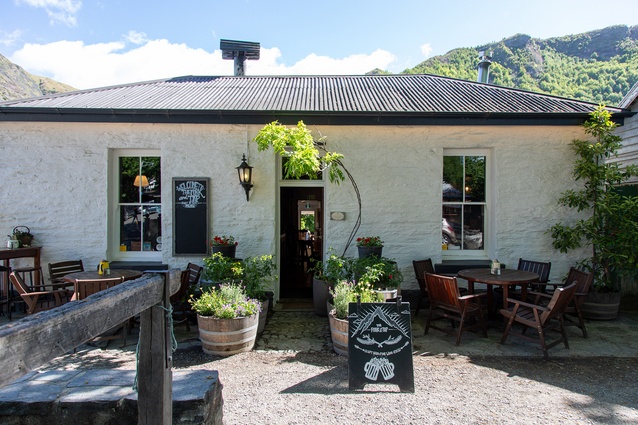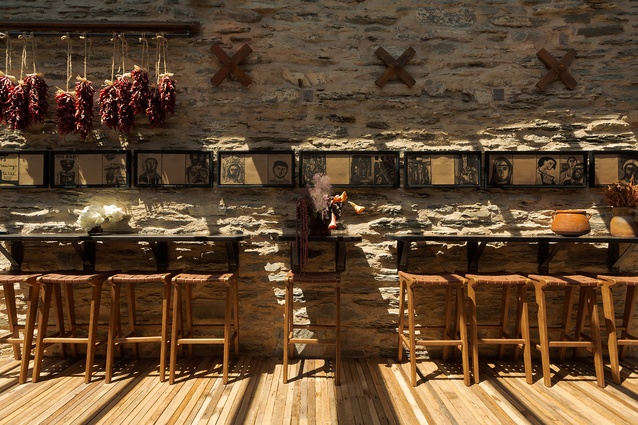Winners revealed: Southern Architecture Awards 2024
Twenty-three architecture projects, covering the region from Queenstown to Invercargill, were recognised in the 2024 Te Kāhui Whaihanga New Zealand Institute of Architects Southern Awards on 17 May at an event in Invercargill at Motorcycle Mecca.
The winners include the first certified Passive House Plus workspace in Aotearoa, a dramatic transformation of a heritage property into a hospitality hub, and eight beautiful new homes.
Dunlop Hub, a commercial building that houses Dunlop builders in Wānaka, won in the Commercial category. Thanks to its Passive House Plus design, masterminded by Pac Studio and Steven Lloyd Architecture, the workspace “leads by example, a place where clientele can see and experience the company’s sustainability ambitions,” the jury says.
Ayrburn, a hospitality precinct by SA Studio, won in the Heritage and Hospitality categories for its top-to-toe strengthening, restoration and transformation of derelict farm buildings into a sophisticated dining destination.
This year’s Housing category celebrates eight projects that are inspired in their architectural planning and execution. Wānaka S.K.I House by Roberts Gray Architects is a case in point, says jury convenor Eliška Lewis.
“This house is a masterpiece. The blank façade gives no hint of the riches, warmth and texture within,” says Lewis.
Six projects won Resene Colour Awards: Verdant House, Intus by Parker Warburton Team Architects, Jasmax’s University of Otago Te Rangihīroa, Ayrburn, Wānaka S.K.I House, and Roost Arrowtown.
“We toured 31 shortlisted projects from Invercargill, Dunedin, Alexandra, Wanaka, Arrowtown and Queenstown, and we were inspired by the dedication and knowledge displayed by the architects. Many projects paid homage to the history of their site and produced buildings that were a privilege to tour,” says Lewis, who was joined on the jury by Guy Marriage of First Light Studio, Erin Taylor of Hyndman Taylor Architecture and architect Gary Todd.
The winning projects are:
Housing
Park House by Studio of Pacific Architecture
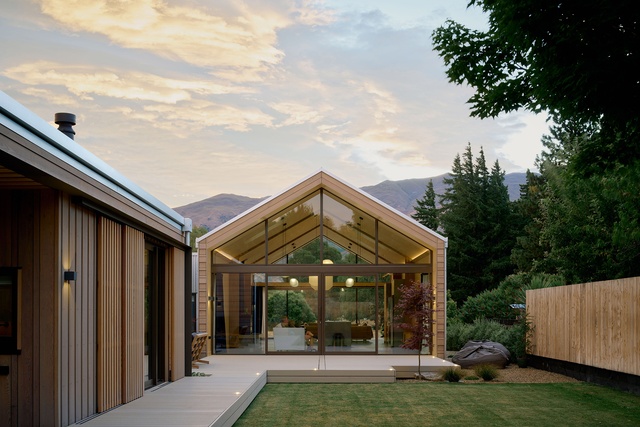
A rousing dialogue between two gabled forms is presented here. The main living form is open, timber-lined, and glazed at each end, while the other is a corrugated closed-off form for the garage. Further up the gently rising site is a third volume, the bedroom wing, where heights and levels soften to present a relaxed atmosphere with carefully considered details.
Vineyard House Anna-Marie Chin Architects
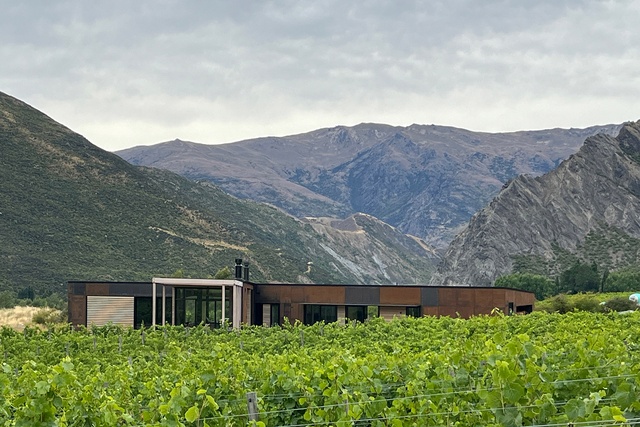
A simple T-shape form has been enhanced with an interplay of sliding walls and disappearing doors, beautiful interior detailing, and steel cladding that will rust and rest this home into the landscape.
Alexandra Rock House by Anna-Marie Chin Architects
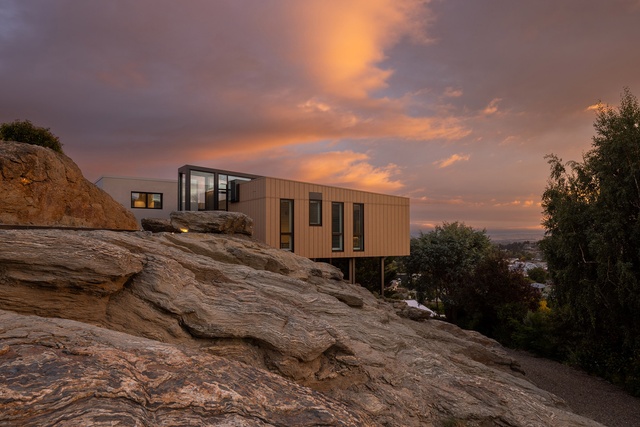
The house is as stunning and unforgiving as the site itself. The entire site has been stripped back to bare rock, revealing a backdrop akin to Palm Springs and its modernist architecture, yet this is contemporary Alexandra. Steel frames rise out of the rock, encasing precast concrete slab floors and a glass floor that reveals the rock beneath. Upstairs, the exterior includes gold-hued aluminium panel cladding, ultra-high-performance glazing and a beautiful interplay of levels suspended above the rock.
Our house by Assembly Architects

Based on a plan from ancient Rome, this is a sophisticated version of the courtyard house, albeit without a peristyle colonnade around a central atrium. Two forms face off across a grassy courtyard, one 10 years older than the other. The established half of the house is finished in black-stained timber, and the newer half is completed in crisp-blonde heat-treated timber. A long time coming to fruition, the result is sophisticated, elegant and well worth the wait. Delectable.
Grendon Street Residence by McCoy and Wixon Architects
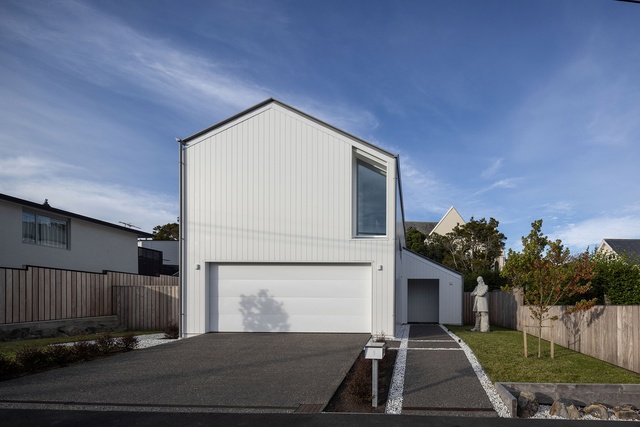
An exercise in white minimalism opens out to provide a series of delightful spaces dressed in a restrained colour palette. Privacy and transparency have been skilfully balanced. The plan makes great use of sunshine pouring into the rear of the site. And it is just the right size — not excessively large, nor uncomfortably small — catering perfectly to the client’s lifestyle. A beautiful canvas for their artwork.
Roys Peak Farmhouse by Rafe Maclean Architects

This is a lovely low-lying triple-tented structure. The three roofs create a Passive House envelope, with floating slabs and SIP panels — all hidden from view behind carefully bunded earth banks. Black aluminium raised-seam cladding wraps the walls and roof. A ‘sneaky’ external accessway between the two forms heightens the journey to the sleepout. Interior timber linings and built-in cabinetry enrich the ambience.
Wānaka S.K.I House by Roberts Gray Architects
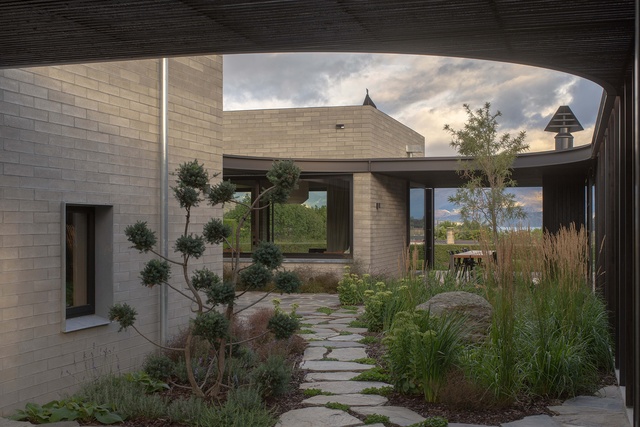
A stark blank façade gives no hint of the riches within — a restrained material palette of half-height concrete blocks, Japanese cedar and oak floors with raw galvanised steel. The cedar cladding has undergone yaki-sugi treatment, while the same cedar has been left raw inside.
Complete with a Japanese-style courtyard garden, the talented design team has created a stunner with their first project, thanks to fantastically friendly client — their parents. While this house may be spending the kids’ inheritance, the integrity of design decisions and assured quality of the finished product suggests money well spent. This house is a masterpiece — the architects are likely to be the vanguard of the future.
Resene Colour Award
The rich interior palette reveals dark timbers, concrete greys and soft greens that resonate with the exterior.
Quarry Hill House by Sheppard & Rout Architects
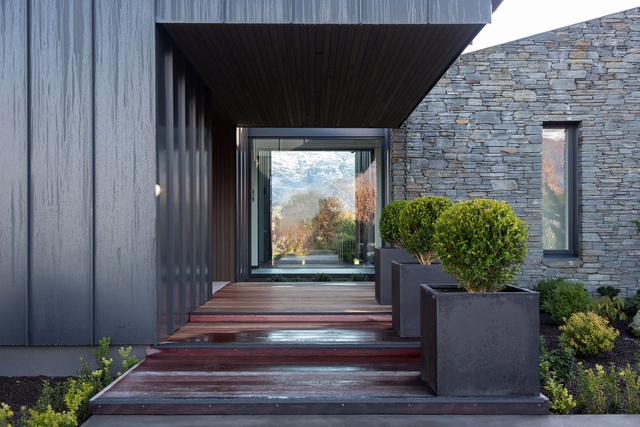
Chiselled stone forms jut skywards, breaking the scale of the building. A considerably generous design for a couple with large-scale personalities to match, this black-white-and-schist house has been meticulously detailed and incredibly well built by skilled craftsmen.
Housing – Multi Unit
University of Otago Te Rangihīroa by Jasmax
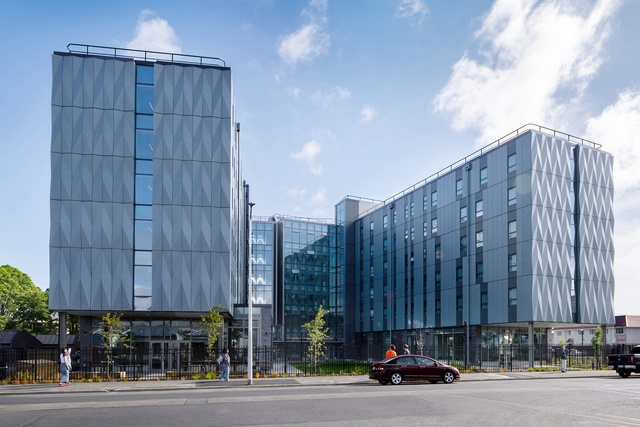
A giant X marks the spot where Sir Peter Buck first went to university and this high-rise building provides hope and accommodation for many more first-year students to come. Taking good care of them is one of the greatest tasks of the education system and Te Rangihīroa excels. Folded aluminium panels provide an ever-changing backdrop and colour coding across the building’s six floors addresses individuality and wayfinding. The elongated cruciform plan accommodates 450 students, and each floor has two common rooms. Te Rangihīroa leads the way as a glowing example of how well our rangatahi can be accommodated and nurtured.
Resene Colour Award
The power of blue and green are used to demarcate levels and lead pathways to calming spaces, while warm timber tones enrich the spirits in communal spaces. As a finishing touch, judicious use of colour is a practical and cost-effective way to elevate otherwise simple materials.
Marina Terrace Apartments by Mason & Wales Architects
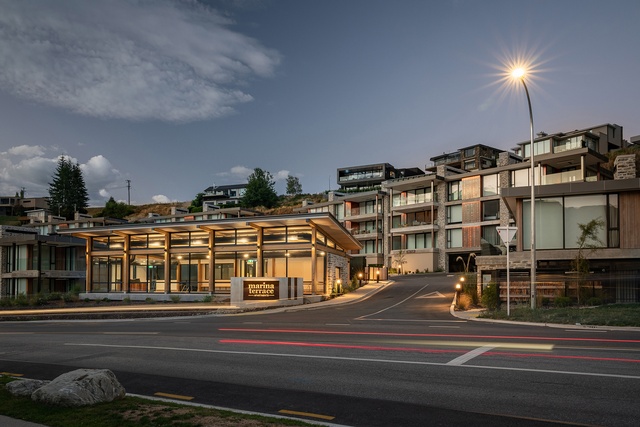
Bob Robertson’s dream of a hotel on this central Wānaka site has been realised in this medium- density apartment development. Use of the internal stairwell is encouraged by its connection with the landscape, and also serves to break up the bulk of a single building into several smaller low-rise blocks. The apartments are luxurious and well-mannered in their ability to fit in with the lake-side setting.
Interior Architecture
Forsyth Barr Dunedin Office Fitout by McAuliffe Stevens
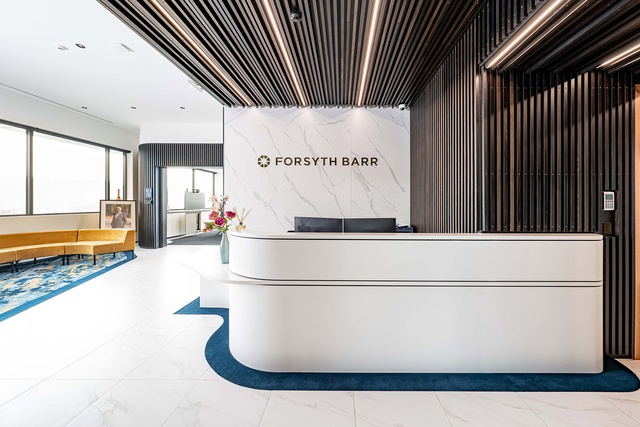
A consummate exercise in black-and-white minimalism, the refurbished offices have been crowned with a new gold ceiling scape that flows throughout the interior. The interior core has been polished and crafted to create an uplifting and inviting atmosphere. A judicious application of timber adds warmth to monochrome efficiency.
Verdant House by Pac Studio and Steven Lloyd Architecture in association
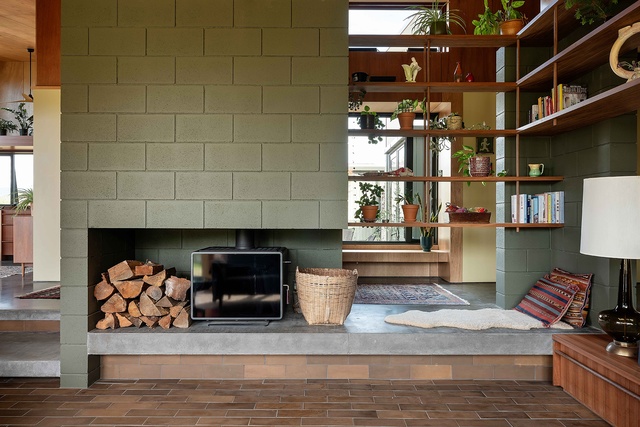
A tight plan houses a beautifully eclectic interior. The sunken lounge — the nucleus of the home — sets up diagonal vignettes to the kitchen, entry and external garden. Cosy nooks, shelving and window seats invite inhabitation. Curated window placement playfully punctuates the exterior. The project is a canvas for the client’s playful eye for layered colour and materiality.
Resene Colour Award
A combination of warm timbers, earthy greens, whites and brick-reds enrich a timeless design that will be enjoyed for generations. This house makes you think you’re on holiday, then the realisation kicks in that you can live this way all-year round. Colours are fun and connect with the beautiful garden.
Intus by Parker Warburton Team Architects

The design of this specialist healthcare facility masters spatial planning. Curves, materiality, a carefully considered colour palette and lighting nurture and soften the transition from arrival to waiting lounge, to naturally lit consultation rooms, to state-of-the-art procedure spaces and then through to recovery. Pathways throughout are easily and intuitively navigated.
The jury witnessed a profoundly positive client response to the design.
Resene Colour Award
The palette is deliberately understated, and with careful attention to detail the result is cohesive. Lighting and colour work together to brighten surfaces where needed and provide warmth to humanise the journey to high-tech areas of the practice.
Public Architecture
Te Puna o Whakaehu by McCoy and Wixon Architects and Maguire and Harford Architects in association

Mosgiel has been blessed by the offspring of an ancient taniwha, with six new swimming pools clustered under a low-slung roof. Set within a silver box spilling into a larger black box, all the details here are just right for a community pool. There is clear interaction with the street, great slot views to the surrounding countryside while swimming, and a masterful series of chunky taniwha teeth cast across the rear wall. This development is a hit — and makes a big splash — with the local community.
Commercial Architecture
Roost Arrowtown by Assembly Architects and Spirus Architecture (Maurice Orr architect) in association
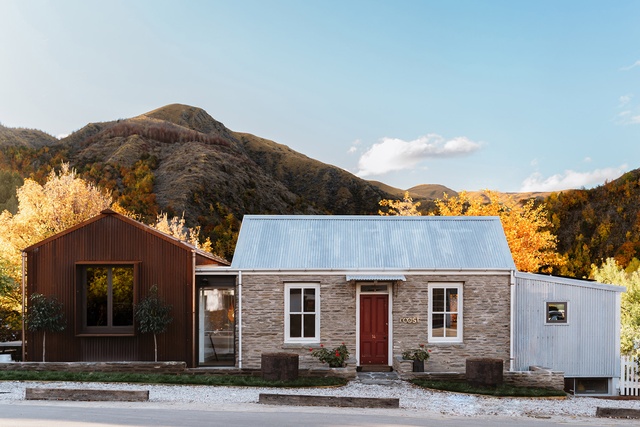
A small and very clever assembly of forms complies with restrictive Arrowtown guidelines and excels at small-scale urban planning. The new stone form plays with a neighbouring rusty shed, while indoors reveals sophisticated working spaces, beautiful internal joinery and joyous pops of colour in unexpected places.
Resene Colour Award
The rusty-brown cladding, mixed with galvanised greys, earthy stonework and a hint of red, is a language that speaks to heritage and culture. Inside, moments of colour delight in unexpected places.
Dunlop Hub by Pac Studio and Steven Lloyd Architecture in association

At one level this is a well-insulated box within a lesser insulated box, however the project goes beyond that limited perspective and raises the bar. Dunlop Hub is the first Certified Passive House Plus workspace in Aotearoa — it leads by example, a place where clientele can see and experience the company’s sustainability ambitions. The interior shows commitment to craft and precision.
Invercargill Central by The Buchan Group

A mammoth undertaking for Invercargill, this development deserves recognition for its contribution to the urban regeneration of an entire city block, and in avoiding the soullessness that is Big Box retailing. Incorporating a multitude of new buildings and parking for 650 cars, the scheme also preserves three prominent heritage buildings. Lighting design successfully showcases the retained heritage façades, with a lively installation to the southern exterior. Glass canopies on heritage façades are delicate and enable views of the beautiful articulation above the street. The architects have laid the foundation for a vibrant city centre.
Education
Columba College Boarding Village by Parker Warburton Team Architects

Modest and perfectly formed, the new rooms available to the Columba College students ensure maximum freedom and minimal confinement. Ground-floor transparency and sunny light-filled spaces support activity. The architects nailed the brief to create a residential-scale village for the students.
Enduring Architecture
Mason & Wales Architects Office Building (1973) by Mason & Wales Architects
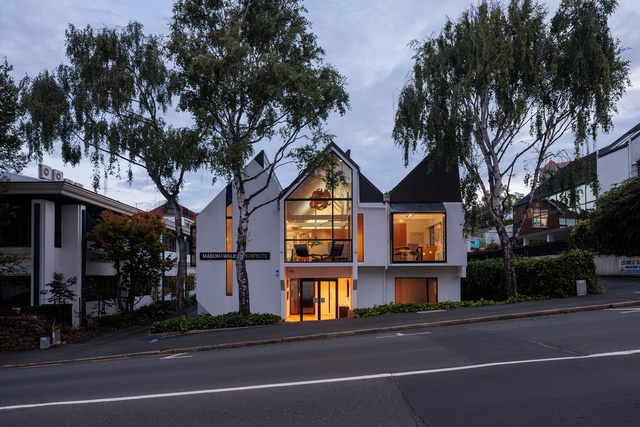
Fifty years on and the building is still occupied by the Mason & Wales team, as well as accommodating the firm’s impressive archive. With its angled roofline and elegant transparency, the building resonates as something special within the streetscape. Form and function remain relevant, making it difficult to pin-point the exact design era — a clear hallmark of enduring architecture. The building is barely changed and yet subtly better in every way.
Heritage
Ayrburn by SA Studio

An astonishing amount of work has been masterminded and detailed by a prodigiously talented young architect. Considerable investment has ensured the top-to-toe strengthening and restoration of derelict farm buildings, which were built more than 150 years ago. The result is a transformation into a sophisticated dining destination. Each meticulously restored part of the building has been given a life that the original inhabitants (pigs, sheep, horses and cattle) could surely never have imagined.
Dunedin Railway Station Restoration by Salmond Reed Architects
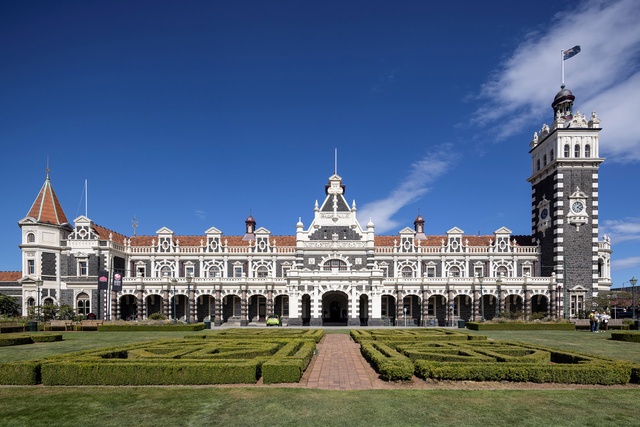
The existing heritage fabric of the main railway station has been enhanced with a back-to-the-future rebuild of the roofline. New copper tiles have been painstakingly created to replace the deteriorated painted fish-scale zinc tiles that were corroding in the central dome, while original copper tiles in the clocktower were dismantled and stripped of modern paint and meticulously refixed. Marseille tiles of the main roofs were removed, cleaned of a century of detritus and replaced, leaving the building looking better than new, but the same as always.
Hospitality
The Fork and Tap by Mary Jowett Architects

It’s difficult to update a much-loved heritage classic, even more so in a hospitality setting when the doors are required to stay open. However, despite other complications including COVID restrictions, this Arrowtown pub closed for only one day when the bar was moved; the local clientele in support of the restoration efforts. The result is two small hip-roofed forms topped with lantern-shaped chimneys, a simple but sophisticated update of all the building’s classic components, a quality outdoor space and much-needed new bathroom facilities. This bar is now set for the next 100 years.
Ayrburn by SA Studio
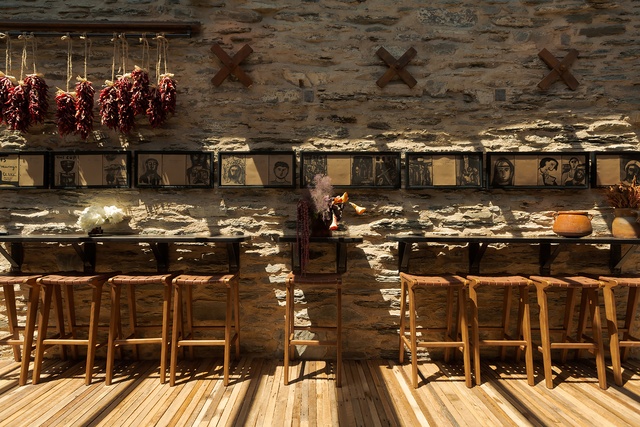
An area of archaeological significance, Ayrburn is making a landmark contribution to the Queenstown Lakes District. A clever repurposing of heritage farm buildings has resulted in perfectly proportioned spaces linked by picturesque landscaping. Not just a place to visit, but a place to thoroughly enjoy, eat, drink and indulge the senses.
Resene Colour Award
Methodically selected colours and textures tell a story of old and new, layer upon layer, celebrating heritage and bringing spaces to life. There’s so much to see! You could frequent this venue for years and every time find a colourful and textural detail that you didn’t notice before.
The NZIA Architecture Awards programme is supported by Resene and APL.

